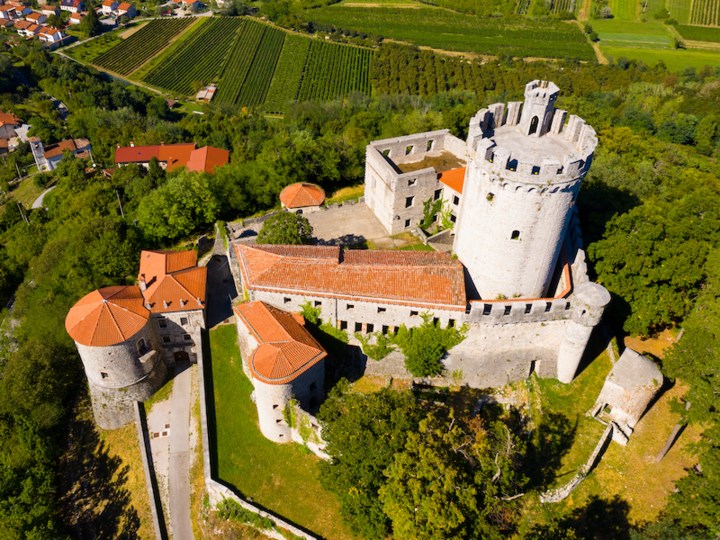Somewhat surprising, but nevertheless true:
Two cities in different countries share a title. Nova Gorica in Slovenia and Gorizia in Italy applied as
twin cities for the title of
European Capital of Culture 2025 and managed to compete against the rivalling Slovenian cities of Ljubljana, Piran and Ptuj. Find out in this article why the title rightly goes to
Italy and Slovenia and interesting facts about the turbulent history and culture of these
picturesque cities at the foot of the Julian Alps.
As the names of the cities suggest,
Nova Gorica and
Gorizia share much more than a title. They were once one city named
Görz, which was under Austrian influence until 1918. A census in 1900 showed that about 63% of the population was Italian, 19% Slovenian and only 11% Austrian. Considering this demographic distribution, it is not surprising that the First World War did not pass by Görz unnoticed. In 1916, the
Italians managed to conquer the city for the first time, but this was reversed the following year when it was
reconquered by the Austro-Hungarian Empire.
In 1918 Görz was again occupied by Italians until the
Treaty of Saint-Germain of 1919, which regulated the dissolution of the Austrian half of the Austro-Hungarian Empire after the First World War, finally resulted in Görz falling to Italy and becoming Gorizia. However, the city' destiny took another turn with the
World War II.

In 1945, the
Yugoslav partisans advanced to the Isonzo River and laid claim to the urban area east of the river. In the Paris Peace Conference of 1947, treaties were drawn up that included border changes, as a result of which
Gorizia was finally divided. To the east of the old town, west of the
Jesenice-Trieste railroad line, in the form of an
ordinary metal fence, the new state border between Italy and Yugoslavia ran across the station square called
Piazza della Transalpina. The eastern part of Gorizia finally became Nova Gorica, which was further developed under the urbanization project of
architect Edvard Ravnikar.
Because of these circumstances,
parallels have often been drawn with Berlin. The comparison is not absurd, but it is somewhat
misleading, since
Italy and Yugoslavia always had a good relationship regarding these cities. Already at that time it manifested itself in
numerous cultural and sporting events, which had a positive effect on coexistence and continued even after the disintegration of Yugoslavia and still do today. What could serve as better proof of transboundary cooperation and
good neighborship than the joint candidacy for the
Capital of Culture 2025?
Fortunately, if you walk along station square today, you will no longer find a metal fence. Since 2007, the border can be crossed at any point without controls.
Walk through the streets of Nova Gorica and Gorizia and convince yourself of the various cultural influences that make these cities of culture so
charming and unique. Most of the sights are within easy walking distance.
Don't forget your camera!

The 11th century
Gorizia Castle rises picturesquely on a hill above the town. Since the late Middle Ages it was the seat of the
Counts of Gorizia, also known as the Meinhardins, who were among the most important noble houses of the
southern Alpine region. Within these ancient walls you have the opportunity to
experience history at first hand. The museum of the Middle Ages is located in the
Knights' Hall. The castle also offers, among other things, an interesting music hall with reproductions of medieval instruments and a chapel with paintings of the Venetian school as well as
Renaissance frescoes.
A variety of sights are located near the castle such as the
18th century Church of St. Ignatius on the Piazza della Vittoria, which was built by Jesuits and contains an impressive altar by the
Venetian painter Gregorio Lazzarini. Visit numerous beautiful buildings that testify to the splendor of times long past. Worth mentioning is certainly the 19th century
Palazzo Attems Petzenstein, which will delight art lovers with its art gallery.
Also the
Theater "Giuseppe Verdi", the Trgovski Dom, built in the style of the Viennese Secession and a popular venue for events, the
House Stisca or House Krainer, which is a prime example of Italian Art Nouveau, the synagogue and many other sights are waiting to be discovered by you. Mingle with the locals and also
enjoy the gastronomic offer in charming cafes such as Caffè Garibaldi or in the restaurants in the city center.
If you are mobile, you should definitely
explore the surroundings of Nova Gorica. In the south of the "
City of Roses" lies the hill
Kostanjevica, where you can find a 17th century
Franciscan monastery of the same name and the Church of the Annunciation. In the crypt rest the last members of the Bourbons, a royal family from France.

North of the city, opposite the hill Kostanjevica, on a hill stands the
beautiful basilica Sveta Gora (eng. Holy Mountain), which has been attracting pilgrims for
more than 400 years. After the climb you will be rewarded with a
breathtaking view and on clear days you can even see
Istria or Venice in the distance.
Nova Gorica and Gorizia are already
working on a lavish cultural program for the year 2025, which will be further developed in the future. In other words,
it remains exciting. If you spend your vacation in
one of our beautiful villas with pool in Istria, you could take a day trip to Nova Gorica and Gorizia and discover yourself the
charm of the European Capital of Culture 2025.
Maja Kovacevic
13.2.2023

 MY ISTRIA GUIDE
MY ISTRIA GUIDE



